NUR2101 Assignment: Chronic Pain, RA, and Patient Information Resource
VerifiedAdded on 2023/01/11
|9
|2607
|53
Project
AI Summary
This assignment presents a comprehensive analysis of a 45-year-old female nurse recently diagnosed with chronic pain from a back injury and Rheumatoid Arthritis (RA). The report details the patient's condition, including the pathophysiology, symptoms, anatomy, and physiology associated with the diseases. It outlines diagnostic approaches, potential complications such as osteoporosis and cardiovascular issues, and considers developmental, cultural, and health literacy considerations. The assignment prioritizes nursing management strategies, encompassing pharmacological and non-pharmacological interventions, and emphasizes the importance of patient education and support. The report also provides management strategies, potential tests, treatments, and medication for the patient. It concludes by summarizing the patient's challenges and the importance of comprehensive care to improve the patient's quality of life.
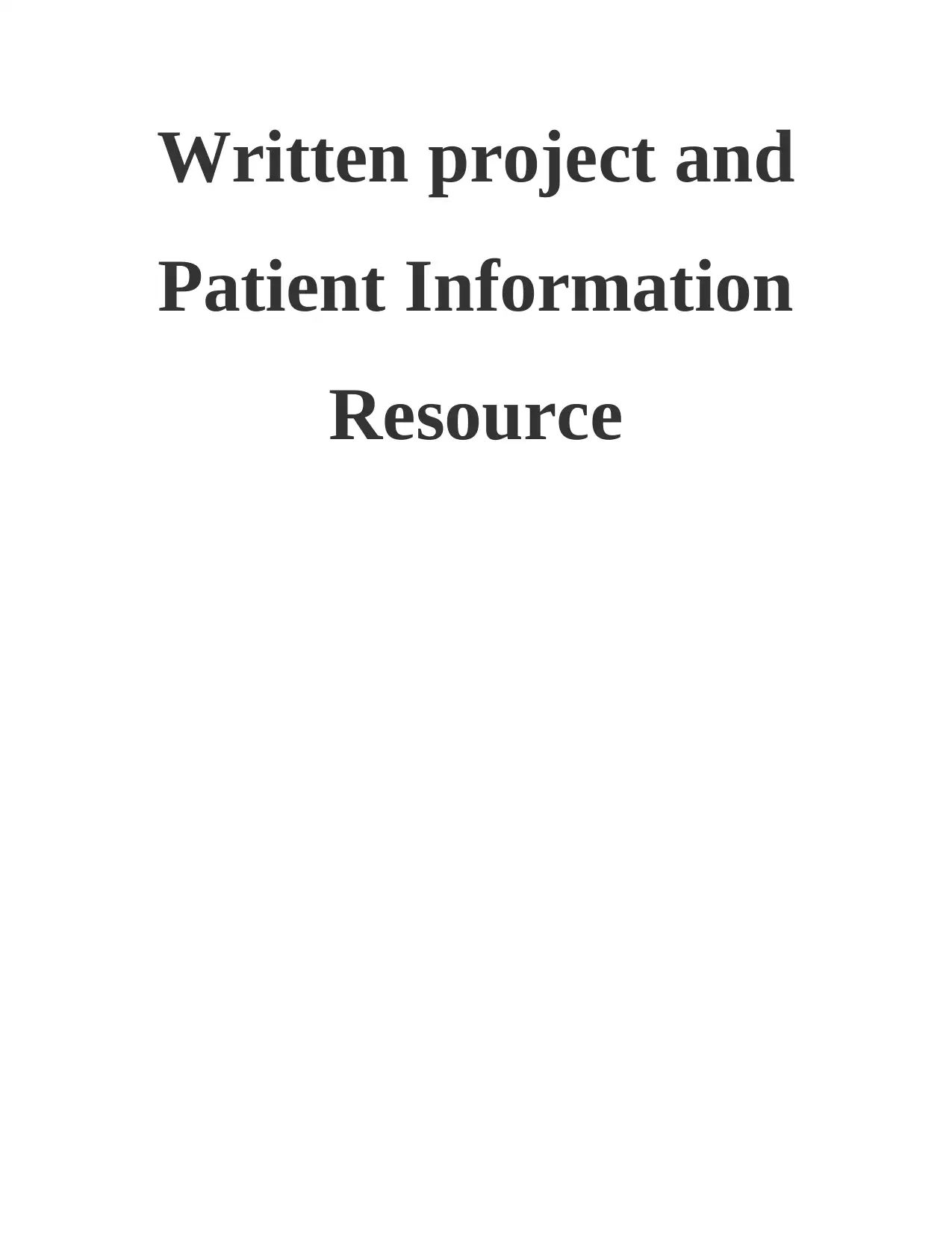
Written project and
Patient Information
Resource
Patient Information
Resource
Paraphrase This Document
Need a fresh take? Get an instant paraphrase of this document with our AI Paraphraser
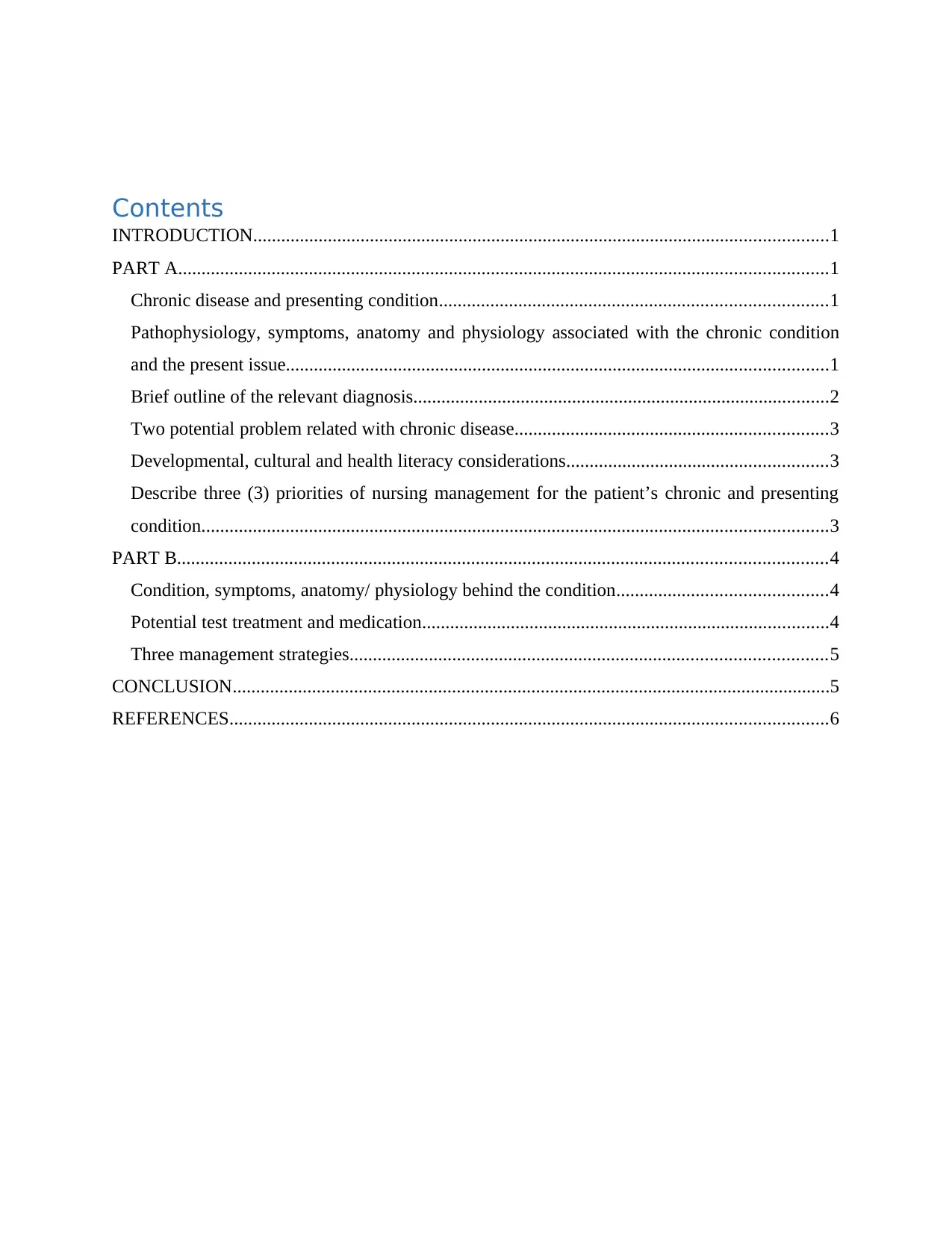
Contents
INTRODUCTION...........................................................................................................................1
PART A...........................................................................................................................................1
Chronic disease and presenting condition...................................................................................1
Pathophysiology, symptoms, anatomy and physiology associated with the chronic condition
and the present issue....................................................................................................................1
Brief outline of the relevant diagnosis.........................................................................................2
Two potential problem related with chronic disease...................................................................3
Developmental, cultural and health literacy considerations........................................................3
Describe three (3) priorities of nursing management for the patient’s chronic and presenting
condition......................................................................................................................................3
PART B...........................................................................................................................................4
Condition, symptoms, anatomy/ physiology behind the condition.............................................4
Potential test treatment and medication.......................................................................................4
Three management strategies......................................................................................................5
CONCLUSION................................................................................................................................5
REFERENCES................................................................................................................................6
INTRODUCTION...........................................................................................................................1
PART A...........................................................................................................................................1
Chronic disease and presenting condition...................................................................................1
Pathophysiology, symptoms, anatomy and physiology associated with the chronic condition
and the present issue....................................................................................................................1
Brief outline of the relevant diagnosis.........................................................................................2
Two potential problem related with chronic disease...................................................................3
Developmental, cultural and health literacy considerations........................................................3
Describe three (3) priorities of nursing management for the patient’s chronic and presenting
condition......................................................................................................................................3
PART B...........................................................................................................................................4
Condition, symptoms, anatomy/ physiology behind the condition.............................................4
Potential test treatment and medication.......................................................................................4
Three management strategies......................................................................................................5
CONCLUSION................................................................................................................................5
REFERENCES................................................................................................................................6
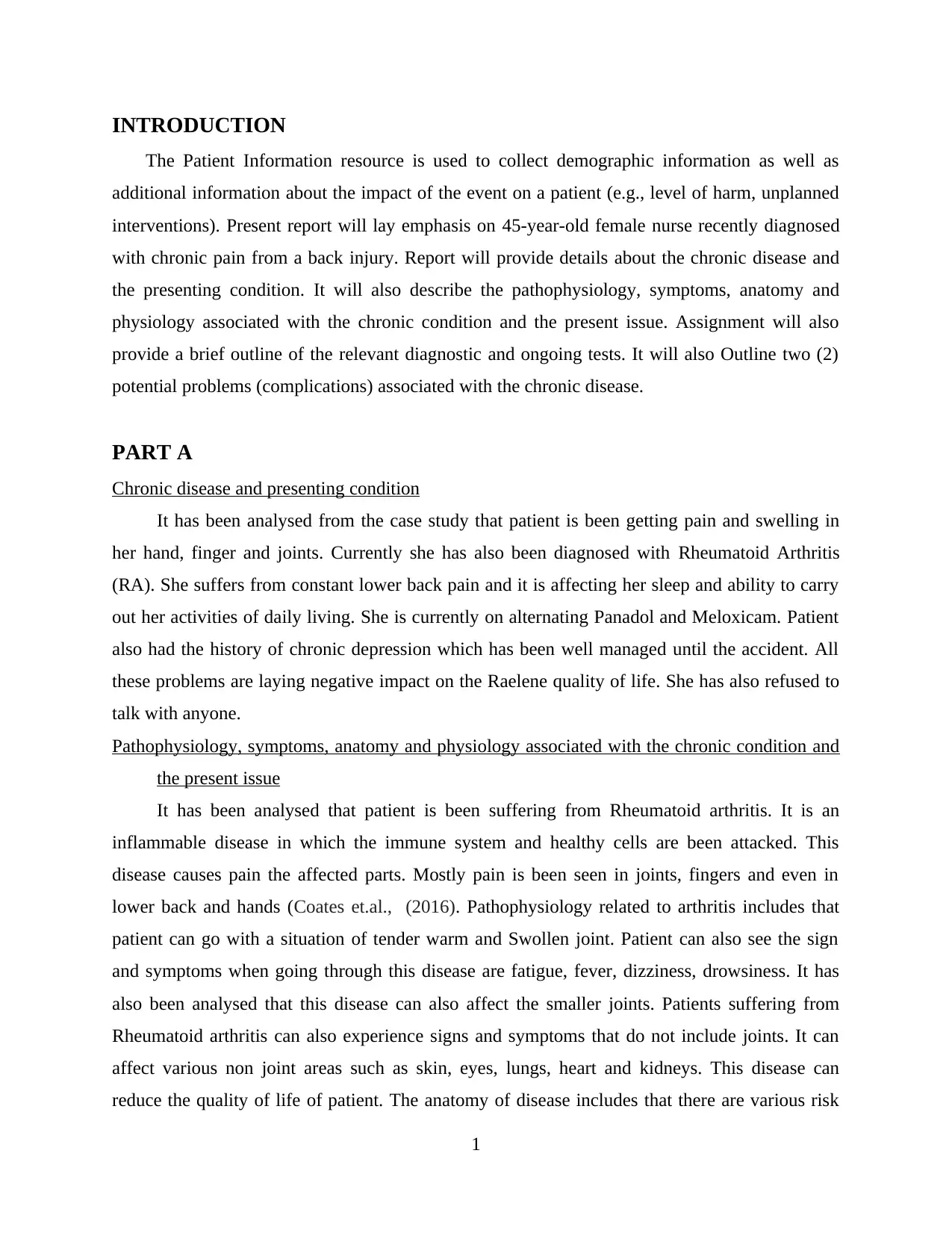
INTRODUCTION
The Patient Information resource is used to collect demographic information as well as
additional information about the impact of the event on a patient (e.g., level of harm, unplanned
interventions). Present report will lay emphasis on 45-year-old female nurse recently diagnosed
with chronic pain from a back injury. Report will provide details about the chronic disease and
the presenting condition. It will also describe the pathophysiology, symptoms, anatomy and
physiology associated with the chronic condition and the present issue. Assignment will also
provide a brief outline of the relevant diagnostic and ongoing tests. It will also Outline two (2)
potential problems (complications) associated with the chronic disease.
PART A
Chronic disease and presenting condition
It has been analysed from the case study that patient is been getting pain and swelling in
her hand, finger and joints. Currently she has also been diagnosed with Rheumatoid Arthritis
(RA). She suffers from constant lower back pain and it is affecting her sleep and ability to carry
out her activities of daily living. She is currently on alternating Panadol and Meloxicam. Patient
also had the history of chronic depression which has been well managed until the accident. All
these problems are laying negative impact on the Raelene quality of life. She has also refused to
talk with anyone.
Pathophysiology, symptoms, anatomy and physiology associated with the chronic condition and
the present issue
It has been analysed that patient is been suffering from Rheumatoid arthritis. It is an
inflammable disease in which the immune system and healthy cells are been attacked. This
disease causes pain the affected parts. Mostly pain is been seen in joints, fingers and even in
lower back and hands (Coates et.al., (2016). Pathophysiology related to arthritis includes that
patient can go with a situation of tender warm and Swollen joint. Patient can also see the sign
and symptoms when going through this disease are fatigue, fever, dizziness, drowsiness. It has
also been analysed that this disease can also affect the smaller joints. Patients suffering from
Rheumatoid arthritis can also experience signs and symptoms that do not include joints. It can
affect various non joint areas such as skin, eyes, lungs, heart and kidneys. This disease can
reduce the quality of life of patient. The anatomy of disease includes that there are various risk
1
The Patient Information resource is used to collect demographic information as well as
additional information about the impact of the event on a patient (e.g., level of harm, unplanned
interventions). Present report will lay emphasis on 45-year-old female nurse recently diagnosed
with chronic pain from a back injury. Report will provide details about the chronic disease and
the presenting condition. It will also describe the pathophysiology, symptoms, anatomy and
physiology associated with the chronic condition and the present issue. Assignment will also
provide a brief outline of the relevant diagnostic and ongoing tests. It will also Outline two (2)
potential problems (complications) associated with the chronic disease.
PART A
Chronic disease and presenting condition
It has been analysed from the case study that patient is been getting pain and swelling in
her hand, finger and joints. Currently she has also been diagnosed with Rheumatoid Arthritis
(RA). She suffers from constant lower back pain and it is affecting her sleep and ability to carry
out her activities of daily living. She is currently on alternating Panadol and Meloxicam. Patient
also had the history of chronic depression which has been well managed until the accident. All
these problems are laying negative impact on the Raelene quality of life. She has also refused to
talk with anyone.
Pathophysiology, symptoms, anatomy and physiology associated with the chronic condition and
the present issue
It has been analysed that patient is been suffering from Rheumatoid arthritis. It is an
inflammable disease in which the immune system and healthy cells are been attacked. This
disease causes pain the affected parts. Mostly pain is been seen in joints, fingers and even in
lower back and hands (Coates et.al., (2016). Pathophysiology related to arthritis includes that
patient can go with a situation of tender warm and Swollen joint. Patient can also see the sign
and symptoms when going through this disease are fatigue, fever, dizziness, drowsiness. It has
also been analysed that this disease can also affect the smaller joints. Patients suffering from
Rheumatoid arthritis can also experience signs and symptoms that do not include joints. It can
affect various non joint areas such as skin, eyes, lungs, heart and kidneys. This disease can
reduce the quality of life of patient. The anatomy of disease includes that there are various risk
1
⊘ This is a preview!⊘
Do you want full access?
Subscribe today to unlock all pages.

Trusted by 1+ million students worldwide

factors related to Rheumatoid arthritis. It has been analysed that women is at greater risk of
developing this problem. It can also be faced by patient if any member of her family is suffering
from this disease. The other risk factor can also include if the patient has a habit of smoking
cigars. It is also associated with greater disease severity (Firestein & McInnes, (2017).
Obese people are also at the more risk of developing this disease. This can reduce the
health outcome and quality of life of patient. Rheumatoid arthritis increases the risk of
developing osteoporosis. This is a condition where bones become weak and are more prone to be
fractured. It has also been analysed that patient is also suffering from depression. This means that
patient is really stressed. The various signs and symptoms related to depression is being anxious,
stressed, sleep deprived, loss of appetite. In present situation patient is not feeling to
communicate and share thoughts with anyone.
Brief outline of the relevant diagnosis
Rheumatoid arthritis can be difficult to be diagnosed at the early stage. There are no proper
physical or blood test which can confirm that Raelene is suffering from this disease. In the
physical assessment health care professional will be engaged in checking the swelling on joints
and fingers of service user (Ritchlin et.al., (2017). It has also been analysed from the case study
that patient has been diagnosed with chronic pain from a back injury. Blood test can be used to
diagnose the chronic pain but not particularly. It can be done in order to see the sign related to
inflammation, infection, cancer or arthritis. It means that blood test can be useful in this situation
for patient. Blood scan also be done to monitor the minor fracture or bone disorder. It will assist
registered nurses in analysing the problem related to health. Computerized tomography can also
be done to patient by health care professionals. This is really useful and helpful in knowing the
tissue structure. X ray imaging can also be used to check upon whether the bones of patients are
not been broken. Health care professional can also be engaged in motivating Raelene for
physiotherapy. This therapy can assist in making patient aware about the correct position to do
certain task. This can support patient reducing the pain which has been faced by her because of
injury. This will help patient in reliving the amount of pain which has been suffered by her. CRP
or ESR blood testing process can be used in order to analyse the inflammation process. In this
situation physiotherapy can also be helpful. The therapist can suggest various new ways to
perform the task.
2
developing this problem. It can also be faced by patient if any member of her family is suffering
from this disease. The other risk factor can also include if the patient has a habit of smoking
cigars. It is also associated with greater disease severity (Firestein & McInnes, (2017).
Obese people are also at the more risk of developing this disease. This can reduce the
health outcome and quality of life of patient. Rheumatoid arthritis increases the risk of
developing osteoporosis. This is a condition where bones become weak and are more prone to be
fractured. It has also been analysed that patient is also suffering from depression. This means that
patient is really stressed. The various signs and symptoms related to depression is being anxious,
stressed, sleep deprived, loss of appetite. In present situation patient is not feeling to
communicate and share thoughts with anyone.
Brief outline of the relevant diagnosis
Rheumatoid arthritis can be difficult to be diagnosed at the early stage. There are no proper
physical or blood test which can confirm that Raelene is suffering from this disease. In the
physical assessment health care professional will be engaged in checking the swelling on joints
and fingers of service user (Ritchlin et.al., (2017). It has also been analysed from the case study
that patient has been diagnosed with chronic pain from a back injury. Blood test can be used to
diagnose the chronic pain but not particularly. It can be done in order to see the sign related to
inflammation, infection, cancer or arthritis. It means that blood test can be useful in this situation
for patient. Blood scan also be done to monitor the minor fracture or bone disorder. It will assist
registered nurses in analysing the problem related to health. Computerized tomography can also
be done to patient by health care professionals. This is really useful and helpful in knowing the
tissue structure. X ray imaging can also be used to check upon whether the bones of patients are
not been broken. Health care professional can also be engaged in motivating Raelene for
physiotherapy. This therapy can assist in making patient aware about the correct position to do
certain task. This can support patient reducing the pain which has been faced by her because of
injury. This will help patient in reliving the amount of pain which has been suffered by her. CRP
or ESR blood testing process can be used in order to analyse the inflammation process. In this
situation physiotherapy can also be helpful. The therapist can suggest various new ways to
perform the task.
2
Paraphrase This Document
Need a fresh take? Get an instant paraphrase of this document with our AI Paraphraser
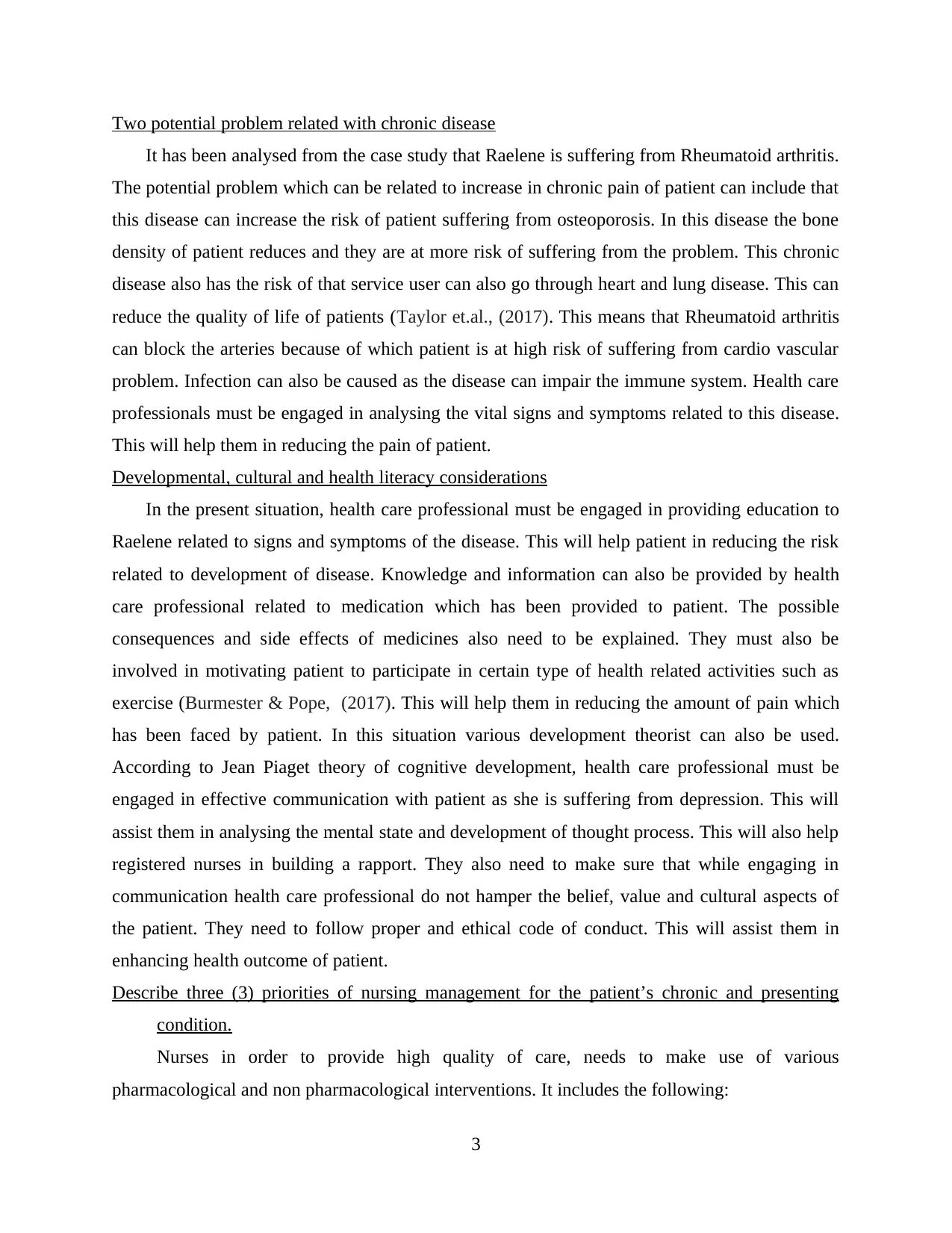
Two potential problem related with chronic disease
It has been analysed from the case study that Raelene is suffering from Rheumatoid arthritis.
The potential problem which can be related to increase in chronic pain of patient can include that
this disease can increase the risk of patient suffering from osteoporosis. In this disease the bone
density of patient reduces and they are at more risk of suffering from the problem. This chronic
disease also has the risk of that service user can also go through heart and lung disease. This can
reduce the quality of life of patients (Taylor et.al., (2017). This means that Rheumatoid arthritis
can block the arteries because of which patient is at high risk of suffering from cardio vascular
problem. Infection can also be caused as the disease can impair the immune system. Health care
professionals must be engaged in analysing the vital signs and symptoms related to this disease.
This will help them in reducing the pain of patient.
Developmental, cultural and health literacy considerations
In the present situation, health care professional must be engaged in providing education to
Raelene related to signs and symptoms of the disease. This will help patient in reducing the risk
related to development of disease. Knowledge and information can also be provided by health
care professional related to medication which has been provided to patient. The possible
consequences and side effects of medicines also need to be explained. They must also be
involved in motivating patient to participate in certain type of health related activities such as
exercise (Burmester & Pope, (2017). This will help them in reducing the amount of pain which
has been faced by patient. In this situation various development theorist can also be used.
According to Jean Piaget theory of cognitive development, health care professional must be
engaged in effective communication with patient as she is suffering from depression. This will
assist them in analysing the mental state and development of thought process. This will also help
registered nurses in building a rapport. They also need to make sure that while engaging in
communication health care professional do not hamper the belief, value and cultural aspects of
the patient. They need to follow proper and ethical code of conduct. This will assist them in
enhancing health outcome of patient.
Describe three (3) priorities of nursing management for the patient’s chronic and presenting
condition.
Nurses in order to provide high quality of care, needs to make use of various
pharmacological and non pharmacological interventions. It includes the following:
3
It has been analysed from the case study that Raelene is suffering from Rheumatoid arthritis.
The potential problem which can be related to increase in chronic pain of patient can include that
this disease can increase the risk of patient suffering from osteoporosis. In this disease the bone
density of patient reduces and they are at more risk of suffering from the problem. This chronic
disease also has the risk of that service user can also go through heart and lung disease. This can
reduce the quality of life of patients (Taylor et.al., (2017). This means that Rheumatoid arthritis
can block the arteries because of which patient is at high risk of suffering from cardio vascular
problem. Infection can also be caused as the disease can impair the immune system. Health care
professionals must be engaged in analysing the vital signs and symptoms related to this disease.
This will help them in reducing the pain of patient.
Developmental, cultural and health literacy considerations
In the present situation, health care professional must be engaged in providing education to
Raelene related to signs and symptoms of the disease. This will help patient in reducing the risk
related to development of disease. Knowledge and information can also be provided by health
care professional related to medication which has been provided to patient. The possible
consequences and side effects of medicines also need to be explained. They must also be
involved in motivating patient to participate in certain type of health related activities such as
exercise (Burmester & Pope, (2017). This will help them in reducing the amount of pain which
has been faced by patient. In this situation various development theorist can also be used.
According to Jean Piaget theory of cognitive development, health care professional must be
engaged in effective communication with patient as she is suffering from depression. This will
assist them in analysing the mental state and development of thought process. This will also help
registered nurses in building a rapport. They also need to make sure that while engaging in
communication health care professional do not hamper the belief, value and cultural aspects of
the patient. They need to follow proper and ethical code of conduct. This will assist them in
enhancing health outcome of patient.
Describe three (3) priorities of nursing management for the patient’s chronic and presenting
condition.
Nurses in order to provide high quality of care, needs to make use of various
pharmacological and non pharmacological interventions. It includes the following:
3

Pharmacological management: It has been analysed that currently patient is been involved
in taking Panadol and Meloxicam for the reduction in pain. These medications are been given so
that pain can be reduced and health outcome of patient can be enhanced. It has also been
analysed that these medications also have certain side effects. The dose of these medications
must be taken in the knowledge of health care professional. This will help nurses in reducing the
effect of Rheumatoid arthritis.
Non pharmacological management: In these nurses can be engaged in motivating patient
to be involved in doing exercise. It will assist Raelene in enhancing the range and motion of the
joints. Finger-splinting and other assistive devices can prevent deformities and improve hand
function. In order to cure depression patient can also get engaged in doing cognitive behavioural
therapy. This will assist them in changing behavioural aspects and can help her in overcoming
depression.
Other management: Health care professional can involve in motivating patient to lose
weight of to be engaged in hot and cold therapy.
PART B
Condition, symptoms, anatomy/ physiology behind the condition
It has been analysed from the case study that patient is been suffering from the Chronic pain
because of the injury. She has also been suffering from depression. It was well managed before
the accident took place (Ravelli et.al., 2017).. The various signs and symptoms related to arthritis
includes that patient can go with a situation of tender warm and Swollen joint. Patient can face
pain in joints or their finger can also be swollen because of it. The various causes for this
condition includes that patient can be obese. Overweigh patient is at high risk of suffering from
this disease. It has also been analysed that one of the major cause is also family history. Research
has provided the details that mainly women suffer from this problem. The disease can also
develop further problem such as osteoporosis, heart and lung disease.
Potential test treatment and medication
It has been analysed that Raelene is been suffering from Rheumatoid arthritis, health care
professional in order to diagnose the disease can motivate patient to undergo certain blood test.
This will help health care professionals in analysing if the pain is caused because of the infection
or any other type of disease (McInnes & Schett, (2017). X ray imaging can also be used to check
4
in taking Panadol and Meloxicam for the reduction in pain. These medications are been given so
that pain can be reduced and health outcome of patient can be enhanced. It has also been
analysed that these medications also have certain side effects. The dose of these medications
must be taken in the knowledge of health care professional. This will help nurses in reducing the
effect of Rheumatoid arthritis.
Non pharmacological management: In these nurses can be engaged in motivating patient
to be involved in doing exercise. It will assist Raelene in enhancing the range and motion of the
joints. Finger-splinting and other assistive devices can prevent deformities and improve hand
function. In order to cure depression patient can also get engaged in doing cognitive behavioural
therapy. This will assist them in changing behavioural aspects and can help her in overcoming
depression.
Other management: Health care professional can involve in motivating patient to lose
weight of to be engaged in hot and cold therapy.
PART B
Condition, symptoms, anatomy/ physiology behind the condition
It has been analysed from the case study that patient is been suffering from the Chronic pain
because of the injury. She has also been suffering from depression. It was well managed before
the accident took place (Ravelli et.al., 2017).. The various signs and symptoms related to arthritis
includes that patient can go with a situation of tender warm and Swollen joint. Patient can face
pain in joints or their finger can also be swollen because of it. The various causes for this
condition includes that patient can be obese. Overweigh patient is at high risk of suffering from
this disease. It has also been analysed that one of the major cause is also family history. Research
has provided the details that mainly women suffer from this problem. The disease can also
develop further problem such as osteoporosis, heart and lung disease.
Potential test treatment and medication
It has been analysed that Raelene is been suffering from Rheumatoid arthritis, health care
professional in order to diagnose the disease can motivate patient to undergo certain blood test.
This will help health care professionals in analysing if the pain is caused because of the infection
or any other type of disease (McInnes & Schett, (2017). X ray imaging can also be used to check
4
⊘ This is a preview!⊘
Do you want full access?
Subscribe today to unlock all pages.

Trusted by 1+ million students worldwide

upon whether the bones of patients are not been broken. It is also been useful for have proper
analysis of the disease which has been faced by patient. Health care professional can also
motivate patient to undergo physiotherapy. The therapist will assist and help Raelene in knowing
the correct position for doing certain task. Panadol and Meloxicam have currently been provided
to patient, so that pain can be reduced. Nurses are also been engaged in making use of evidence
based intervention for enhancing health outcome of patient.
Three management strategies
There are various management strategies which can be used by health care professional to
enhance the health outcome of Raelene. They can motivate her to be involved in following
healthy life style. This can be taken as the non pharmacological intervention. Nurses can make
use of multimodal approach in order to reduce the chronic pain faced by patient. They can also
motivate Raelene to reduce weight as obese patient’s faces this problem more. Education can
also be provided on various signs and symptoms related to disease. Health care professionals can
also motivate patient to not be engaged in smoking cigars. This will assist in reducing
consequences related to disease which has been faced by patient. . Health care professionals must
be engaged in analysing the vital signs and symptoms related to this disease. This will help them
in reducing the pain of patient.
Additional resource you tube link: <https://www.youtube.com/watch?v=Qa4JkgKDaR0>
CONCLUSION
From the above study, it has been summarized that patient has been facing problem related
to chronic pain because of the injury. It has also been analyzed that patient has also been
suffering from depression and she is reluctant to communicate with anyone. Various types of
therapies such as physiotherapy can be provided by health care professionals to patient in order
to reduce the pain which has been faced by patient. This has assisted them in enhancing quality
of life of patient.
5
analysis of the disease which has been faced by patient. Health care professional can also
motivate patient to undergo physiotherapy. The therapist will assist and help Raelene in knowing
the correct position for doing certain task. Panadol and Meloxicam have currently been provided
to patient, so that pain can be reduced. Nurses are also been engaged in making use of evidence
based intervention for enhancing health outcome of patient.
Three management strategies
There are various management strategies which can be used by health care professional to
enhance the health outcome of Raelene. They can motivate her to be involved in following
healthy life style. This can be taken as the non pharmacological intervention. Nurses can make
use of multimodal approach in order to reduce the chronic pain faced by patient. They can also
motivate Raelene to reduce weight as obese patient’s faces this problem more. Education can
also be provided on various signs and symptoms related to disease. Health care professionals can
also motivate patient to not be engaged in smoking cigars. This will assist in reducing
consequences related to disease which has been faced by patient. . Health care professionals must
be engaged in analysing the vital signs and symptoms related to this disease. This will help them
in reducing the pain of patient.
Additional resource you tube link: <https://www.youtube.com/watch?v=Qa4JkgKDaR0>
CONCLUSION
From the above study, it has been summarized that patient has been facing problem related
to chronic pain because of the injury. It has also been analyzed that patient has also been
suffering from depression and she is reluctant to communicate with anyone. Various types of
therapies such as physiotherapy can be provided by health care professionals to patient in order
to reduce the pain which has been faced by patient. This has assisted them in enhancing quality
of life of patient.
5
Paraphrase This Document
Need a fresh take? Get an instant paraphrase of this document with our AI Paraphraser
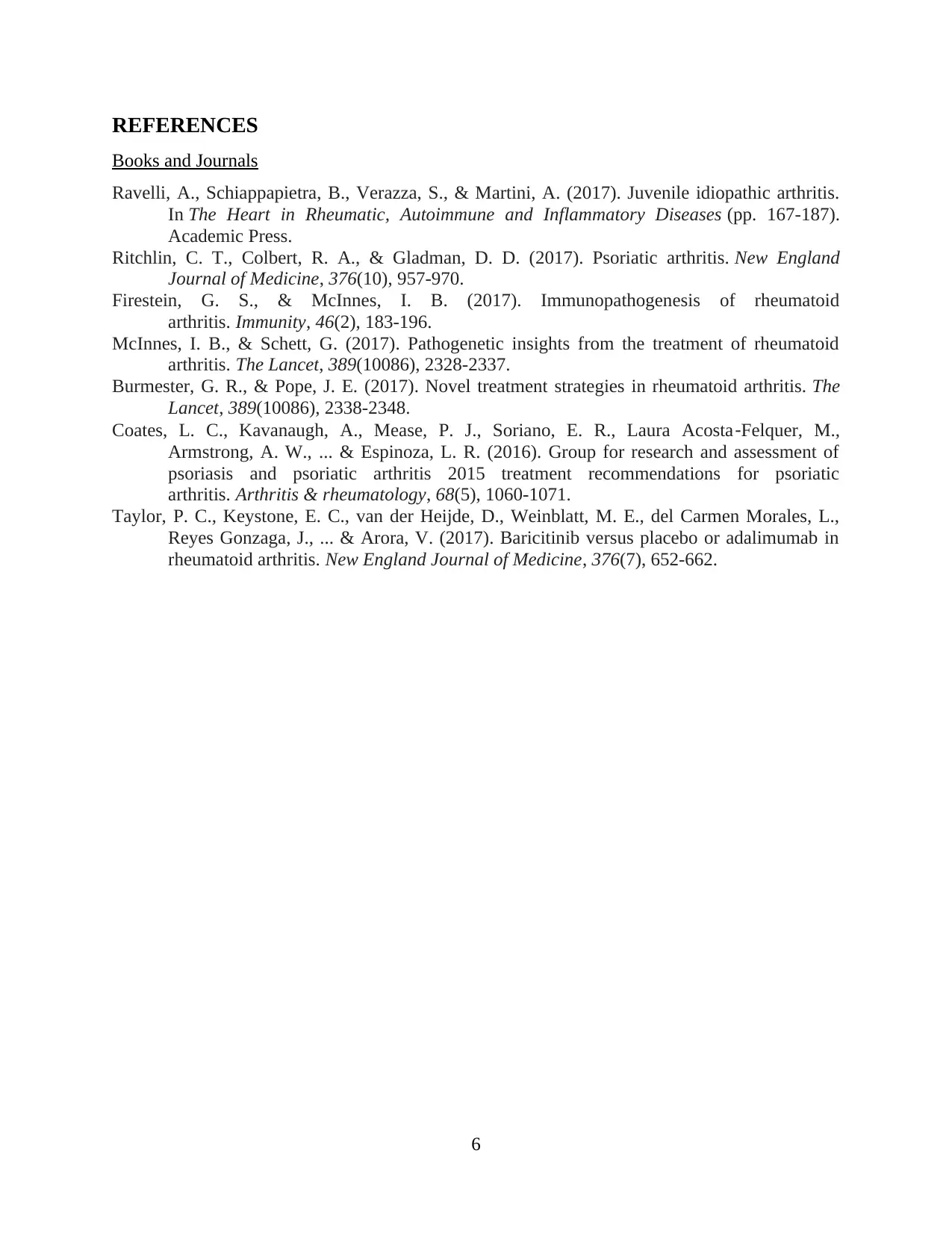
REFERENCES
Books and Journals
Ravelli, A., Schiappapietra, B., Verazza, S., & Martini, A. (2017). Juvenile idiopathic arthritis.
In The Heart in Rheumatic, Autoimmune and Inflammatory Diseases (pp. 167-187).
Academic Press.
Ritchlin, C. T., Colbert, R. A., & Gladman, D. D. (2017). Psoriatic arthritis. New England
Journal of Medicine, 376(10), 957-970.
Firestein, G. S., & McInnes, I. B. (2017). Immunopathogenesis of rheumatoid
arthritis. Immunity, 46(2), 183-196.
McInnes, I. B., & Schett, G. (2017). Pathogenetic insights from the treatment of rheumatoid
arthritis. The Lancet, 389(10086), 2328-2337.
Burmester, G. R., & Pope, J. E. (2017). Novel treatment strategies in rheumatoid arthritis. The
Lancet, 389(10086), 2338-2348.
Coates, L. C., Kavanaugh, A., Mease, P. J., Soriano, E. R., Laura Acosta‐Felquer, M.,
Armstrong, A. W., ... & Espinoza, L. R. (2016). Group for research and assessment of
psoriasis and psoriatic arthritis 2015 treatment recommendations for psoriatic
arthritis. Arthritis & rheumatology, 68(5), 1060-1071.
Taylor, P. C., Keystone, E. C., van der Heijde, D., Weinblatt, M. E., del Carmen Morales, L.,
Reyes Gonzaga, J., ... & Arora, V. (2017). Baricitinib versus placebo or adalimumab in
rheumatoid arthritis. New England Journal of Medicine, 376(7), 652-662.
6
Books and Journals
Ravelli, A., Schiappapietra, B., Verazza, S., & Martini, A. (2017). Juvenile idiopathic arthritis.
In The Heart in Rheumatic, Autoimmune and Inflammatory Diseases (pp. 167-187).
Academic Press.
Ritchlin, C. T., Colbert, R. A., & Gladman, D. D. (2017). Psoriatic arthritis. New England
Journal of Medicine, 376(10), 957-970.
Firestein, G. S., & McInnes, I. B. (2017). Immunopathogenesis of rheumatoid
arthritis. Immunity, 46(2), 183-196.
McInnes, I. B., & Schett, G. (2017). Pathogenetic insights from the treatment of rheumatoid
arthritis. The Lancet, 389(10086), 2328-2337.
Burmester, G. R., & Pope, J. E. (2017). Novel treatment strategies in rheumatoid arthritis. The
Lancet, 389(10086), 2338-2348.
Coates, L. C., Kavanaugh, A., Mease, P. J., Soriano, E. R., Laura Acosta‐Felquer, M.,
Armstrong, A. W., ... & Espinoza, L. R. (2016). Group for research and assessment of
psoriasis and psoriatic arthritis 2015 treatment recommendations for psoriatic
arthritis. Arthritis & rheumatology, 68(5), 1060-1071.
Taylor, P. C., Keystone, E. C., van der Heijde, D., Weinblatt, M. E., del Carmen Morales, L.,
Reyes Gonzaga, J., ... & Arora, V. (2017). Baricitinib versus placebo or adalimumab in
rheumatoid arthritis. New England Journal of Medicine, 376(7), 652-662.
6

7
⊘ This is a preview!⊘
Do you want full access?
Subscribe today to unlock all pages.

Trusted by 1+ million students worldwide
1 out of 9
Related Documents
Your All-in-One AI-Powered Toolkit for Academic Success.
+13062052269
info@desklib.com
Available 24*7 on WhatsApp / Email
![[object Object]](/_next/static/media/star-bottom.7253800d.svg)
Unlock your academic potential
Copyright © 2020–2025 A2Z Services. All Rights Reserved. Developed and managed by ZUCOL.





